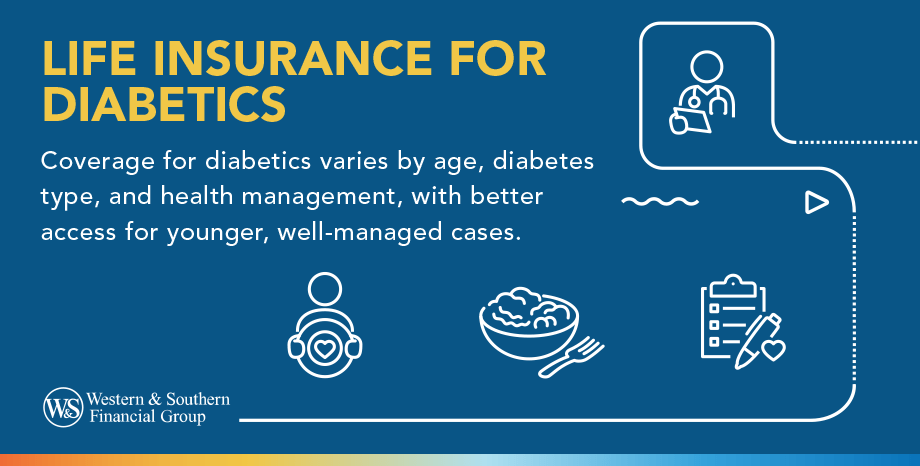

Table of Contents
Key Takeaways
- Health, age, type of diabetes, and its management are crucial factors insurers consider when determining life insurance coverage for diabetics.
- People with well-managed diabetes, especially type 2, and a generally good health profile may have better chances of obtaining coverage.
- Type 1 diabetes may result in higher premiums compared to type 2 diabetes.
- Different life insurance options are available, such as term life insurance, universal life insurance, and simplified issue life insurance.
- Individuals with diabetes should carefully consider their options and choose coverage that suits their needs.
If you have a preexisting condition, it's natural to worry you may not qualify for life insurance. That fear may be especially acute if you have diabetes.
However, life insurance for people with diabetes remains a possibility. Many insurers take a closer look at people with diabetes, and depending on various factors, you may still qualify, even if it's at a higher premium. So, before you dismiss the possibility of life insurance for people with type 1 diabetes or type 2 diabetes, take some time to understand what insurers look into and explore your potential options.
Here's what you should know about life insurance for people with diabetes.
The Factors Insurers Consider
Health plays a significant role in the ability to secure life insurance. Typically, the younger and healthier you are, the easier it is to find coverage options for your needs.
However, several preexisting conditions may impact your ability to get life insurance — diabetes being one of them. Having diabetes may also increase the likelihood of having other health risk factors, such as heart disease, which insurers will investigate as part of your overall health.
That being said, insurers typically don't simply see someone with diabetes and automatically refuse coverage. There are several factors insurers look at to determine if you may qualify.
These include:
- Your age: Insurers will likely want to know your current age and when you were first diagnosed with diabetes.
- The type of diabetes: Your ability to get coverage may depend heavily on the type of diabetes you have.
- How it's managed: Insurers will also likely look at the severity of your diabetes and how you're currently controlling it. That may include the types of medications you're on and any other treatments you use.
- Your general health: Your overall health is another factor. If you are otherwise in good health and maintain an active lifestyle, that may be a positive factor for insurers.
If you struggle with managing your diabetes or you aren't trying to manage it at all, it could significantly impact your ability to get life insurance.
In general, if you are younger, otherwise healthy and are actively managing your diabetes with medical supervision and keeping it under control, you may have a better chance of getting coverage. However, as a person with diabetes, you'll likely pay a higher premium compared with someone without such a condition.
Does the Type of Diabetes I Have Matter?
There are two different types of diabetes, and depending on which one you have, insurers may determine your preexisting condition is riskier. However, working with medical professionals to manage your diabetes and sticking to a healthy and active lifestyle could help improve your chances of getting coverage.
Type 1 Diabetes
Type 1 is a less common form of diabetes that is often diagnosed in children and young adults. Life insurance for people with type 1 diabetes is potentially available, especially if you are younger and otherwise healthy. If you can get coverage, you may have to pay a higher premium.
Type 2 Diabetes
Type 2 is a much more common form of diabetes, which may mean more coverage options. It's typically diagnosed while in adulthood, and many people have mild symptoms.
Something else to consider is, in many cases, type 2 diabetes can be successfully managed with a healthy lifestyle. If you are otherwise healthy and have your diabetes under control, you may be able to pay a lower premium than those with type 1.
What Kind of Options Are Available for People With Diabetes?
As you explore your options, keep in mind that your insurer will make the final determination based on the previously mentioned factors. Some insurers will also require a medical exam or ask you to submit blood and urine samples before processing your application. Here are a few life insurance products to consider.
Term Life Insurance
With a term life insurance policy, you pick the duration of your coverage, usually running between 10 and 30 years. It typically offers lower premiums. A medical exam may be required.
Universal Life Insurance
You may qualify for universal life insurance. It's a product that can last for your entire life as long as your premiums are paid. A hallmark of universal life insurance is its flexibility of premiums, and some policies also allow you to change their death benefit. You can decrease to a smaller death benefit or add coverage without buying a new policy. A medical exam is typically required.
Simplified Issue Life Insurance
If your diabetes isn't well controlled, or if it's at an advanced stage, you may qualify for a simplified issue life insurance policy. The coverage is capped at lower amounts, has a higher premium and is designed for those 50 and older. Depending on the insurer, you may not need to take a medical exam for coverage.
The Bottom Line
Choosing a life insurance policy is a serious matter, especially if you have diabetes. Consider your options and look for coverage that best suits your needs.















